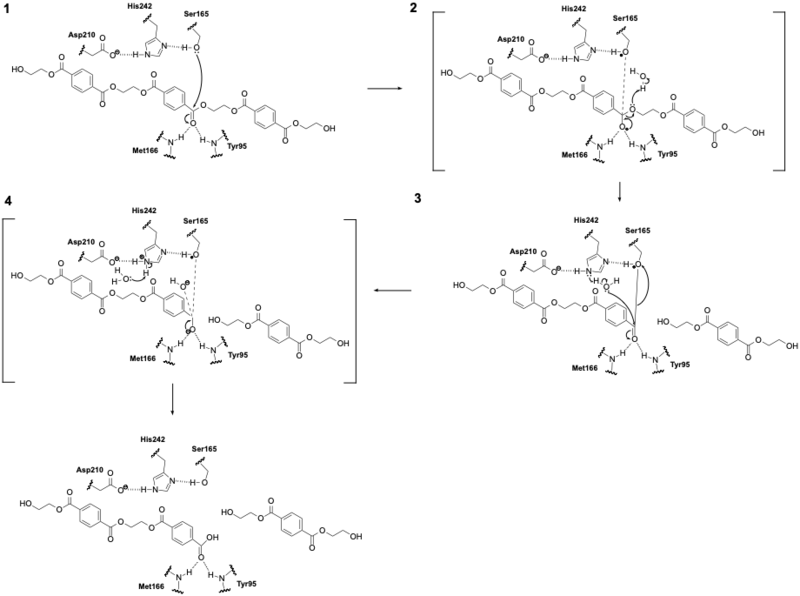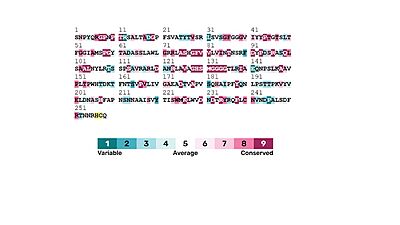Sandbox Reserved 1845
From Proteopedia
(Difference between revisions)
| Line 40: | Line 40: | ||
=== Phe243 === | === Phe243 === | ||
| - | <scene name='10/1075247/F243_original/1'>Phe243</scene> is located 3.6 Å from the ligand,<scene name='10/1075247/Original_15_mutation_structure/6'>Reference Phe243</scene>. Two mutations at this position, <scene name='10/1075247/F243i/1'>F243I</scene> and F243W, increase the catalytic activity of the enzyme. The F243I mutation inserts the smaller isoleucine whose side chain allows the ligand to sit closer. This reduces the ligand distance to 3.0 Å, improving substrate binding. The F243W mutation inserts the bulkier, nitrogen-containing aromatic aide chain. Trp brings the ligand slightly closer at 3.2 Å and introduces potential for new interactions, such as hydrogen bonding or [https://en.wikipedia.org/wiki/Pi-stacking#:~:text=In%20chemistry%2C%20pi%20stacking%20(also,interaction%22)%20is%20electrostatically%20repulsive. π-stacking]. Both mutations result in improved catalytic performance. The F243I mutant shows a 27.5% increase in activity, while the F243W mutant shows a 17.5% increase, compared to the wild-type enzyme.<ref name="Tournier"/> | + | <scene name='10/1075247/F243_original/1'>Phe243</scene> is located 3.6 Å from the ligand, <scene name='10/1075247/Original_15_mutation_structure/6'>Reference Phe243</scene>. Two mutations at this position, <scene name='10/1075247/F243i/1'>F243I</scene> and F243W, increase the catalytic activity of the enzyme. The F243I mutation inserts the smaller isoleucine whose side chain allows the ligand to sit closer. This reduces the ligand distance to 3.0 Å, improving substrate binding. The F243W mutation inserts the bulkier, nitrogen-containing aromatic aide chain. Trp brings the ligand slightly closer at 3.2 Å and introduces potential for new interactions, such as hydrogen bonding or [https://en.wikipedia.org/wiki/Pi-stacking#:~:text=In%20chemistry%2C%20pi%20stacking%20(also,interaction%22)%20is%20electrostatically%20repulsive. π-stacking]. Both mutations result in improved catalytic performance. The F243I mutant shows a 27.5% increase in activity, while the F243W mutant shows a 17.5% increase, compared to the wild-type enzyme.<ref name="Tournier"/> |
=== Tyr 127 === | === Tyr 127 === | ||
| - | The mutation of Tyr to Gly at <scene name='10/1075247/Y127/4'>Tyr127</scene> also increases the thermostability,<scene name='10/1075247/Original_15_mutation_structure/6'>Reference | + | The mutation of Tyr to Gly at <scene name='10/1075247/Y127/4'>Tyr127</scene> also increases the thermostability,<scene name='10/1075247/Original_15_mutation_structure/6'>Reference Tyr127</scene>. The melting point of Y127G is increased to 87.0°C from the WT melting point of 84.7°C. Tyr has a bulky, rigid aromatic side chain that can cause structural strain, shown in <scene name='10/1075247/Y127_spacefill/1'>Y127 representation</scene>. Gly is the smallest amino acid and lacks a side chain, providing greater flexibility. The mutation <scene name='10/1075247/Y127g/2'>Y127G</scene> melting point is increased to 87.0°C. The mutation reduces [https://en.wikipedia.org/wiki/Steric_effects#:~:text=Steric%20hindrance%20is%20the%20slowing,as%20slowing%20unwanted%20side%2Dreactions. steric hindrance] and relieves strain in the protein structure, demonstrated in <scene name='10/1075247/Y127g_space_fill/1'>Y127G representation</scene>. By increasing flexibility, the Y127G mutation helps the protein maintain its folded structure under heat stress.<ref name="Tournier"/> |
=== Ser 283 & Asp 238 === | === Ser 283 & Asp 238 === | ||
Current revision
| This Sandbox is Reserved from March 18 through September 1, 2025 for use in the course CH462 Biochemistry II taught by R. Jeremy Johnson and Mark Macbeth at the Butler University, Indianapolis, USA. This reservation includes Sandbox Reserved 1828 through Sandbox Reserved 1846. |
To get started:
More help: Help:Editing |
Leaf Branch Compost Cutinase
| |||||||||||
References
- ↑ 1.0 1.1 1.2 1.3 1.4 1.5 1.6 1.7 Tournier V, Topham CM, Gilles A, David B, Folgoas C, Moya-Leclair E, Kamionka E, Desrousseaux ML, Texier H, Gavalda S, Cot M, Guemard E, Dalibey M, Nomme J, Cioci G, Barbe S, Chateau M, Andre I, Duquesne S, Marty A. An engineered PET depolymerase to break down and recycle plastic bottles. Nature. 2020 Apr;580(7802):216-219. doi: 10.1038/s41586-020-2149-4. Epub 2020 Apr, 8. PMID:32269349 doi:http://dx.doi.org/10.1038/s41586-020-2149-4
- ↑ 2.0 2.1 2.2 2.3 2.4 Sui B, Wang T, Fang J, Hou Z, Shu T, Lu Z, Liu F, Zhu Y. Recent advances in the biodegradation of polyethylene terephthalate with cutinase-like enzymes. Front Microbiol. 2023 Oct 2;14:1265139. PMID:37849919 doi:10.3389/fmicb.2023.1265139
- ↑ Ueda H, Tabata J, Seshime Y, Masaki K, Sameshima-Yamashita Y, Kitamoto H. Cutinase-like biodegradable plastic-degrading enzymes from phylloplane yeasts have cutinase activity. Biosci Biotechnol Biochem. 2021 Jul 23;85(8):1890-1898. PMID:34160605 doi:10.1093/bbb/zbab113
- ↑ Kolattukudy PE. Biopolyester membranes of plants: cutin and suberin. Science. 1980 May 30;208(4447):990-1000. PMID:17779010 doi:10.1126/science.208.4447.990
- ↑ 5.0 5.1 5.2 5.3 5.4 Khairul Anuar NFS, Huyop F, Ur-Rehman G, Abdullah F, Normi YM, Sabullah MK, Abdul Wahab R. An Overview into Polyethylene Terephthalate (PET) Hydrolases and Efforts in Tailoring Enzymes for Improved Plastic Degradation. Int J Mol Sci. 2022 Oct 20;23(20):12644. PMID:36293501 doi:10.3390/ijms232012644
- ↑ 6.0 6.1 Burgin T, Pollard BC, Knott BC, Mayes HB, Crowley MF, McGeehan JE, Beckham GT, Woodcock HL. The reaction mechanism of the Ideonella sakaiensis PETase enzyme. Commun Chem. 2024 Mar 27;7(1):65. PMID:38538850 doi:10.1038/s42004-024-01154-x
- ↑ 7.0 7.1 7.2 Zhang J, Wang H, Luo Z, Yang Z, Zhang Z, Wang P, Li M, Zhang Y, Feng Y, Lu D, Zhu Y. Computational design of highly efficient thermostable MHET hydrolases and dual enzyme system for PET recycling. Commun Biol. 2023 Nov 9;6(1):1135. PMID:37945666 doi:10.1038/s42003-023-05523-5
- ↑ Yoshida S, Hiraga K, Takehana T, Taniguchi I, Yamaji H, Maeda Y, Toyohara K, Miyamoto K, Kimura Y, Oda K. A bacterium that degrades and assimilates poly(ethylene terephthalate). Science. 2016 Mar 11;351(6278):1196-9. doi: 10.1126/science.aad6359. PMID:26965627 doi:http://dx.doi.org/10.1126/science.aad6359
- ↑ Landrigan PJ, Stegeman JJ, Fleming LE, Allemand D, Anderson DM, Backer LC, Brucker-Davis F, Chevalier N, Corra L, Czerucka D, Bottein MD, Demeneix B, Depledge M, Deheyn DD, Dorman CJ, Fénichel P, Fisher S, Gaill F, Galgani F, Gaze WH, Giuliano L, Grandjean P, Hahn ME, Hamdoun A, Hess P, Judson B, Laborde A, McGlade J, Mu J, Mustapha A, Neira M, Noble RT, Pedrotti ML, Reddy C, Rocklöv J, Scharler UM, Shanmugam H, Taghian G, van de Water JAJM, Vezzulli L, Weihe P, Zeka A, Raps H, Rampal P. Human Health and Ocean Pollution. Ann Glob Health. 2020 Dec 3;86(1):151. PMID:33354517 doi:10.5334/aogh.2831
- ↑ Jambeck JR, Geyer R, Wilcox C, Siegler TR, Perryman M, Andrady A, Narayan R, Law KL. Marine pollution. Plastic waste inputs from land into the ocean. Science. 2015 Feb 13;347(6223):768-71. PMID:25678662 doi:10.1126/science.1260352
Student Contributors
Ashley Callaghan, Rebecca Hoff, & Simone McCowan



